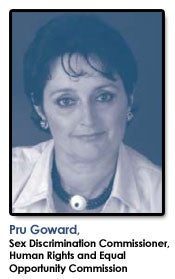20 Years on: The Challenges Continue - Foreword
20 Years on: The Challenges Continue.
Foreword
Sexual harassment is unlawful and has been for 20 years.
However, it is a perennial issue, deeply embedded in many Australian workplace
cultures. Recognising this, over the last 20 years the Human Rights and
Equal Opportunity Commission ("HREOC") has regularly focussed its public
education programs on the issue of sexual harassment. Two decades after
the introduction of the Sex Discrimination Act 1984 (Cth) (the
"SDA") it seemed timely to me that we review our knowledge and management
of sexual harassment. This review examines the way in which HREOC manages
complaints, updates the Sexual
Harassment: A Code of Practice ("Code of Practice") (which was
first developed in 1996) and examines experiences of sexual harassment
in the community.
The review began with A
Bad Business: Review of sexual harassment in employment complaints 2002 ("A Bad Business"), an analysis of the sexual harassment in employment
complaints finalised by HREOC in 2002.
A Bad Business provided excellent information about
the nature of complaints to HREOC but it did not, and could not, provide
information about the general incidence and nature of sexual harassment
in the Australian community and its impact on victims, perpetrators, employers
and other workplace participants.
To address these issues, HREOC commissioned the Gallup Organization
to undertake a telephone survey, Australia's first national survey of
sexual harassment in the general community.
The purpose of the telephone survey and associated research
was to provide a robust quantitative analysis of the incidence and nature
of sexual harassment in the Australian community. Further, by comparing
the results of the telephone survey with the findings of A Bad Business,
it might be possible to identify where the SDA, the Code of Practice,
HREOC's education materials or its complaints protocols might be improved
to better address the sexual harassment experience of Australians. It
might also prove useful to employers, employer organisations and unions
in updating their sexual harassment codes and procedures. A tall order!
The telephone survey has good news and bad. It has confirmed
that the incidence of sexual harassment in Australia is broadly comparable
with that of other like countries. Eighteen per cent of all respondents
in the telephone survey had been harassed at work (28 per cent of women,
seven per cent of men). This figure is comparable to the New Zealand experience
(15 per cent) but a little lower than an Australian TMP Worldwide survey
and earlier United States surveys which suggested that as many as 44 per
cent of women were sexually harassed at work.[1]
Overall, the telephone survey found 28 per cent of adult Australians
had experienced sexual harassment at some time in public life; 41 per
cent of all women and 14 per cent of all men.
Most sexual harassment in the survey involved men harassing
women, but significantly, 21 per cent of identified harassers were female
- mostly harassing male victims.
This gender breakdown is not reflected in complaints to HREOC,
such as those reviewed in A Bad Business, suggesting that male
targets are more unwilling to address sexual harassment and that men might
need to be made more aware of their rights to protection from sexual harassment.
The telephone survey has also identified co-workers as the
most likely harassers with employers or supervisors making up another
third. Again, this is broadly in line with A Bad Business, although
harassment by co-workers may be more likely to be ignored by targets or
dealt with successfully within the workplace.
None of this should come as a surprise, but it was important that it be quantitatively confirmed.
The telephone survey also has good news; it confirms
that other workers who witness harassment are overwhelmingly likely to
take an active role in addressing it, including confronting the harasser.
Far from being a "boys' club" workforce that condones sexual harassment,  Australians
Australians
are prepared to do the right thing by their fellow workers, which should
further encourage employers to implement sexual harassment prevention
and reporting policies.
Finally, the telephone survey confirms that in the majority
of sexual harassment cases, action is taken against the harasser by management
when a complaint is made, but that sadly, 68 per cent of the targets of
workplace sexual harassment do not formally complain, often because they
believed there would be no management support. Employers would do well
to examine their workplace environments and ensure that sexual harassment
complaints procedures are implemented and seen to be implemented by staff.
While A Bad Business published by HREOC in 2003
should have provided some useful guidance to employers and managers, the
telephone survey is even more useful in assisting in the prevention of
sexual harassment and in the development of appropriate policies. The
revised Code of Practice should also be a useful tool for employers and
managers. The telephone survey will also be informative in any reviews
of legislative, policy or procedural efforts to deal with sexual harassment.
Footnotes
1. These are discussed
at 2.2.2.
Foreword >> Executive Summary
Last updated:
24 March 2004.
